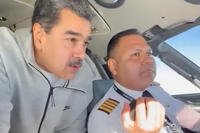Search-and-rescue efforts continued Thursday for eight Air Force crew members still missing after a CV-22 Osprey crashed into the ocean off the coast of southern Japan, as Japanese officials grounded their aircraft and called on the U.S. military to do the same.
The Air Force and Pentagon provided no new details on the cause of the 353rd Special Operations Wing training crash Wednesday off Yakushima Island or on the status of the U.S. aircrew, confirming only that the search of the ocean was continuing as efforts stretched into the second day.
"Emergency personnel remain on scene conducting search-and-rescue operations," Pentagon spokeswoman Sabrina Singh said Thursday. "The cause of this incident is currently under investigation."
A Wednesday statement from Air Force Special Operations Command said the CV-22B Osprey was on a training mission off the shore of the island with eight airmen aboard.
Japanese Coast Guard officials told local outlets and The Associated Press that one person who had been recovered from the crash was dead, but U.S. military officials -- who often won't confirm the identity of troops who die until next of kin has been notified -- have not confirmed that information on the record.
While U.S. officials remained tight-lipped about the crash, multiple Japanese officials were publicly vocal about their concerns with the aircraft following the incident and called for their own country's fleet of Ospreys to be grounded amid investigations into Wednesday's crash.
Local media outlets in the country as well as the AP reported that a senior Japanese Defense Ministry official, Taro Yamato, said during a parliamentary hearing that Japan has suspended flights of Ospreys. The Japanese Self-Defense Forces have 14 Ospreys in their fleet.
Japanese Chief Cabinet Secretary Hirokazu Matsuno also told reporters the country asked the U.S. to ground its Ospreys in Japan, unless they're being utilized for the search-and-rescue efforts, until "their safety is confirmed," the AP reported.
Japanese Defense Minister Minoru Kihara also said in a parliamentary hearing Thursday that the country requested the U.S. to conduct flights of Ospreys "after their flight safety is confirmed."
"The occurrence of such a major accident causes great anxiety to the people of the region, and it is truly regrettable," Kihara said.
Singh told reporters during a Pentagon press briefing Thursday that the department was not tracking an official request from the Japanese government. When asked whether the ally should not be concerned with the safety of the V-22, Singh said she was "not going to speak for the Japanese government" and responded only by saying an investigation is ongoing.
"Right now, the Ospreys are still operating in Japan,” Singh said. “Right now, our focus … remains on search-and-rescue efforts.”
In addition to a series of deadly incidents in recent history with the Osprey, there have also been concerns with the Marine Corps aircraft in the same region just two months ago.
Military.com reported that on Sept. 14, within just two hours of each other, two Marine V-22 Ospreys diverted due to "cockpit caution indications" in the aircraft while flying near Japan's southwestern island chain.
The aircraft landed safely, the service said at that time, and no injuries or fatalities were reported by the Marine Corps.
The latest deadly crash occurred with a Marine Corps Osprey in Australia in August, claiming the lives of three Marines. Another Marine Corps Osprey went down last year in Southern California, killing five Marines. Investigation findings released in July showed the cause of that crash in California was a hard clutch engagement, or HCE, a mechanical issue that has plagued the aircraft for more than a decade.
Despite those problems, Air Force and Pentagon officials have told Military.com in recent months that they remain confident in the aircraft.
When asked by reporters Thursday whether that was still the case, Singh didn't directly answer the question. Instead, she stressed that she didn't want to get ahead of the investigation and that "there's a true commitment to safety when it comes to any of our airmen operating any aircraft."
Lt. Gen. Tony Bauernfeind, the head of Air Force Special Operations Command, told Military.com in September that the command is following mitigation steps issued over the last year to combat HCE incidents.
"We're very confident in the mitigation steps that we've done," Bauernfeind said. "With respect to the CV-22 at large, it is answering a long-held requirement ... that no other capability can answer in the special operations community as we go forward."
The HCE mechanical issue can cause the shredding of components needed to power the Osprey's propellers and to keep the aircraft flying in the event of a single-engine failure.
The issue became public only after the Air Force abruptly grounded its Osprey fleet in August 2022 over a cluster of such incidents. Yet the Marine Corps, which operates the lion's share of the military's Osprey fleet, said the very next day that it didn't need to ground its aircraft.
Military.com exclusively reported on a 2017 clutch incident with an Air Force Osprey that happened mid-flight and forced the aircraft to perform an emergency landing with a single engine.
In June 2022, a Marine Corps Osprey -- call sign Swift 11 -- crashed in southern California, claiming the lives of five Marines. In March, the Marine Corps investigation found that they were the first deaths stemming from the HCE problem.
The cause of Wednesday's crash still remains under investigation. Japan's military was continuing to assist in search-and-rescue efforts on Thursday.
A Navy official told Military.com that following Wednesday's crash the service responded with two helicopters from the aircraft carrier USS Carl Vinson, which was in the area, as well as a P-8 Poseidon maritime patrol and reconnaissance aircraft.
-- Thomas Novelly can be reached at thomas.novelly@military.com. Follow him on X @TomNovelly.
-- Konstantin Toropin can be reached at konstantin.toropin@military.com. Follow him on X at @ktoropin.
Related: Rescue Efforts Underway for 8 Crew Members Aboard Air Force Osprey That Crashed in Japan













